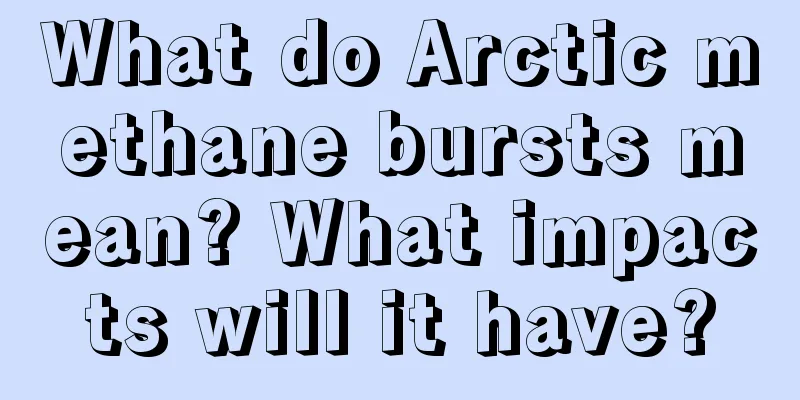What do Arctic methane bursts mean? What impacts will it have?

|
The Arctic methane burst refers to the fact that the permafrost in the entire Arctic region is melting rapidly, and lakes formed by ice water are everywhere, with methane bubbling out of the lakes. Recently, the Arctic methane explosion has also become a hot topic. So, what do Arctic methane bursts mean? What impacts will it bring? 1. What does the Arctic methane explosion mean? 1. Food shortage We know that our rainy season and dry season are mainly caused by changes in ocean currents, and agriculture in most areas relies on this phenomenon to grow crops. If a large amount of methane is released in the Arctic, the greenhouse effect may cause the global climate to get out of control and humans will face the risk of food shortages. 2. Virus outbreak Furthermore, the permafrost may contain viruses. We know that there may be remains of living things under the glaciers. For example, scientists have excavated a 42,000-year-old foal and a 100,000-year-old mammoth from the permafrost. In addition, scientists have extracted viruses from the remains of some organisms. Although the Spanish flu has disappeared from the human world for nearly 100 years, scientists have extracted the virus from human remains in the permafrost. 3. Threat to human health If global warming causes permafrost and glaciers to melt, these viruses may flow into local ecosystems along with meltwater from ice and snow, potentially threatening the health of organisms and even humans. 2. What impacts will the Arctic methane explosion bring? 1. It causes global warming When we talk about greenhouse gases, we usually think of carbon dioxide, but did you know? Methane is also a greenhouse gas. In 2018, the United States used comprehensive data obtained from the South Great Plains Observatory in Oklahoma to prove for the first time that methane may also aggravate the greenhouse effect on the earth. Moreover, the greenhouse effect caused by methane is 25 times that of carbon dioxide. It is understood that the Arctic is a natural methane reservoir. There is a large amount of methane under the glaciers and permafrost. This methane may be produced by the decomposition of microorganisms after the death of previous vegetation. Due to the low temperature in the Arctic, methane can combine with water to form solid methane ice. The amount of methane ice stored in solid form is 164 times that of gas in the same volume. 2. Affected areas This dramatic warming is not limited to the Arctic Ocean region, but extends to the surrounding snowfields, ice fields and permafrost, deep into much of Siberia, Alaska, Canada, Greenland and Scandinavia. In 2007, temperatures in northern North America rose by about 2°C above the average for 1951-1980, and parts of Siberia rose by more than 3°C. Hundreds of metres of permafrost are at risk of melting – the Arctic is not just a fragile mirror but also a vast repository of carbon and methane, greenhouse gases locked up in the frozen soil or buried in ice structures beneath the seabed. The real concern, however, is the organic carbon contained in the permafrost, in the form of plants and animals that died long ago. For example, the bizarre woolly mammoth has been frozen for tens of thousands of years. When the permafrost thaws, much of that carbon is likely to be released into the atmosphere. |
>>: Completely ban illegal wildlife trade! What are the wild animals in our country?
Recommend
Why do household brands continue to advertise?
Why do many household brands continue to advertis...
What are the hot topics in mobile development in 2015?
It has been 8 years since Steve Jobs launched the...
WeChat 7.0.4 is officially launched, adding many new features, and font changes have become a hot topic
WeChat, a social software owned by Tencent, is ve...
Aurora: A Magnificent Symphony of Solar Wind and Earth's Magnetic Field
Aurora is a colorful plasma phenomenon that occur...
The secret to healthy running: How to take every right step?
Review expert: Peng Guoqiu, deputy chief physicia...
The ultimate showdown of portable Bluetooth speakers: Sony SRS-XB20 and JBL compete to see who wins
Portable Bluetooth speakers are still an emerging...
Foreign media: China's electric cars are actually very dirty
According to foreign media reports, China has mad...
What are the real user needs?
It is said that making products must meet user ne...
Dabohui's live streaming sales system course from entry to mastery, four major instructors will guide you to play Douyin live streaming sales
Dabohui's live streaming sales system course f...
What is it like to have a "nitpicker" around you?
Mixed Knowledge Specially designed to cure confus...
What should we do if the ocean also loses hair? Its "hair transplanter" turns out to be seaweed
Produced by: Science Popularization China Author:...
Cao Yuan made another major breakthrough and published two results in succession, and the four-layer "magic angle" twisted graphene was born!
[Mobile software: BoKeYuan] Graphene is composed ...
New media operation: 10 methods to dig deep into materials!
More and more people are entering the new media i...
How to efficiently create a set of creative information flow materials?
The article is mainly divided into three parts: P...
With an idle rate of up to 70%, why have small household appliances become the “bottom of the box”?
In the past few days, Ms. Liu cleaned her house a...









